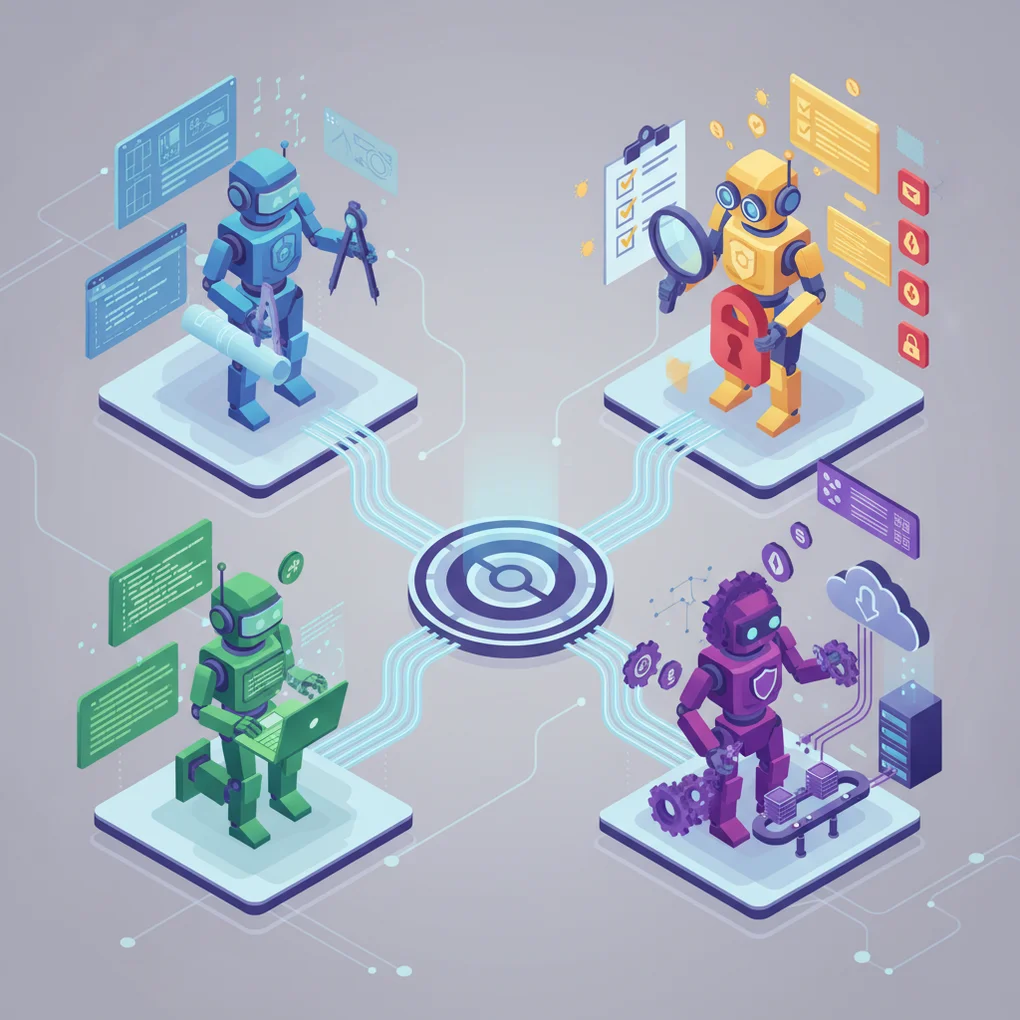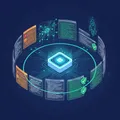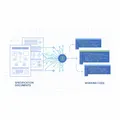
AI Agent Collaboration Patterns: Building Full-Stack Apps with 5 Specialized Agents
Orchestrate Architecture, Coding, Testing, Security, and DevOps agents to build production-grade applications
The Multi-Agent Era Has Arrived
In 2025, AI development reached a new turning point. We’ve evolved from single AI agents handling all tasks to multi-agent systems where specialized agents collaborate.
One developer orchestrating five specialized agents to build a full-stack application—this is today’s reality.
Why Multi-Agent?
Limitations of Single Agents:
- Context window constraints (one AI can’t remember everything)
- Lack of expertise (can’t be proficient in all domains)
- No parallel processing (can only perform one task at a time)
Strengths of Multi-Agent Systems:
- Division of Labor & Specialization: Each agent focuses on specific areas
- Parallel Execution: Multiple tasks processed simultaneously
- Scalability: Functionality expands by adding new agents
- Resilience: One agent’s failure doesn’t affect the entire system
In practice, Toyota saved over 10,000 hours annually with multi-agent systems, while an e-commerce API project achieved 70% bug reduction and 75% faster refactoring.
Architecture of 5 Specialized Agents
The ideal agent configuration for full-stack application development:
1. Architecture Agent
Role: System design and structural decisions
Core Responsibilities:
- System architecture design (microservices, monolithic, serverless, etc.)
- Database schema design
- Technology stack selection
- Component interface definition
- Scalability and performance considerations
Output Example:
## System Architecture
### Technology Stack
- Frontend: React 18 + TypeScript
- Backend: Node.js (Express) + TypeScript
- Database: PostgreSQL 15 + Redis (caching)
- Infrastructure: AWS (ECS Fargate, RDS, ElastiCache)
### Component Structure
```
frontend/
├── components/ # React components
├── hooks/ # Custom hooks
├── services/ # API clients
└── store/ # State management (Zustand)
backend/
├── domain/ # Business logic
├── application/ # Use cases
├── infrastructure/ # DB, external APIs
└── presentation/ # REST controllers
```
### Database Schema
```sql
CREATE TABLE users (
id UUID PRIMARY KEY,
email VARCHAR(255) UNIQUE NOT NULL,
created_at TIMESTAMP DEFAULT NOW()
);
CREATE TABLE posts (
id UUID PRIMARY KEY,
user_id UUID REFERENCES users(id),
title VARCHAR(255) NOT NULL,
content TEXT,
published_at TIMESTAMP
);
```2. Coding Agent
Role: Code implementation and generation
Core Responsibilities:
- Implement Architecture Agent’s designs into actual code
- Write business logic
- Implement API endpoints
- Develop frontend components
- Code review and refactoring
Real-World Results:
- 35% reduction in implementation time (professional developer study)
- 27% decrease in defect rates
Implementation Example:
// Architecture Agent Design → Coding Agent Implementation
// domain/user.entity.ts
export class User {
constructor(
public readonly id: string,
public readonly email: string,
public readonly createdAt: Date
) {}
static create(email: string): User {
return new User(
crypto.randomUUID(),
email,
new Date()
);
}
}
// application/user.service.ts
export class UserService {
constructor(private userRepository: UserRepository) {}
async createUser(email: string): Promise<User> {
const existingUser = await this.userRepository.findByEmail(email);
if (existingUser) {
throw new Error('User already exists');
}
const user = User.create(email);
await this.userRepository.save(user);
return user;
}
}
// presentation/user.controller.ts
export class UserController {
constructor(private userService: UserService) {}
async create(req: Request, res: Response) {
try {
const { email } = req.body;
const userId = req.user!.id; // Injected by auth middleware
const user = await this.userService.createUser(email);
res.status(201).json(user);
} catch (error) {
res.status(400).json({ error: error.message });
}
}
}3. Testing Agent
Role: Automated test creation and quality assurance
Core Responsibilities:
- Generate unit tests
- Write integration tests
- Implement E2E test scenarios
- Analyze test coverage
- Detect and report bugs
Test Example:
// user.service.test.ts
describe('UserService', () => {
let userService: UserService;
let mockRepository: jest.Mocked<UserRepository>;
beforeEach(() => {
mockRepository = {
findByEmail: jest.fn(),
save: jest.fn(),
} as any;
userService = new UserService(mockRepository);
});
describe('createUser', () => {
it('should create a new user successfully', async () => {
const email = 'test@example.com';
mockRepository.findByEmail.mockResolvedValue(null);
mockRepository.save.mockResolvedValue(undefined);
const user = await userService.createUser(email);
expect(user.email).toBe(email);
expect(mockRepository.save).toHaveBeenCalledWith(
expect.objectContaining({ email })
);
});
it('should throw error if user already exists', async () => {
const email = 'existing@example.com';
const existingUser = User.create(email);
mockRepository.findByEmail.mockResolvedValue(existingUser);
await expect(userService.createUser(email)).rejects.toThrow(
'User already exists'
);
});
it('should generate valid UUID for user ID', async () => {
mockRepository.findByEmail.mockResolvedValue(null);
const user = await userService.createUser('test@example.com');
expect(user.id).toMatch(
/^[0-9a-f]{8}-[0-9a-f]{4}-4[0-9a-f]{3}-[89ab][0-9a-f]{3}-[0-9a-f]{12}$/i
);
});
});
});
// Integration test
describe('User API Integration', () => {
it('POST /users should create user and return 201', async () => {
const response = await request(app)
.post('/users')
.send({ email: 'integration@test.com' })
.expect(201);
expect(response.body).toMatchObject({
email: 'integration@test.com',
id: expect.any(String),
createdAt: expect.any(String)
});
});
});4. Security Agent
Role: Security vulnerability detection and defense
Core Responsibilities:
- Code security scanning
- Vulnerability detection (SQL injection, XSS, CSRF, etc.)
- Compliance verification (GDPR, HIPAA)
- Security recommendations
- Threat analysis and mitigation strategies
Security Checklist Example:
## Security Checklist
### Input Validation
- [x] Validate all user inputs (Joi/Zod schemas)
- [x] Prevent SQL injection (parameterized queries)
- [x] Prevent XSS (input sanitization)
- [x] Validate file uploads (MIME types, size limits)
### Authentication & Authorization
- [x] Password hashing (bcrypt, cost factor 12)
- [x] JWT token expiration (access 15min, refresh 7days)
- [x] Rate limiting (100 requests per 15 minutes per IP)
- [x] Force HTTPS (production)
### Data Protection
- [x] Manage secrets via environment variables
- [x] Database encryption (at-rest, in-transit)
- [x] CORS whitelist configuration
- [x] Prevent sensitive information logging
### Compliance
- [x] GDPR: User data deletion API
- [x] Log retention policy (90 days)
- [x] Privacy policy updateVulnerability Report Example:
// ❌ Vulnerability detected by Security Agent
app.get('/user/:id', (req, res) => {
const query = `SELECT * FROM users WHERE id = '${req.params.id}'`;
// SQL Injection risk!
db.query(query, (err, result) => {
res.json(result);
});
});
// ✅ Fix suggested by Security Agent
app.get('/user/:id', async (req, res) => {
const { id } = req.params;
// Input validation
const schema = Joi.object({
id: Joi.string().uuid().required()
});
const { error } = schema.validate({ id });
if (error) {
return res.status(400).json({ error: 'Invalid user ID' });
}
// Parameterized query
const result = await db.query(
'SELECT * FROM users WHERE id = $1',
[id]
);
res.json(result.rows[0]);
});5. DevOps Agent
Role: CI/CD, deployment, and monitoring
Core Responsibilities:
- CI/CD pipeline configuration
- Infrastructure provisioning (Terraform, CloudFormation)
- Containerization (Docker, Kubernetes)
- Monitoring and alerting setup
- Performance optimization
Real-World Results: Chemical industry case achieved 30% reduction in quality failures
CI/CD Pipeline Example:
# .github/workflows/deploy.yml
name: Deploy to Production
on:
push:
branches: [main]
jobs:
test:
runs-on: ubuntu-latest
steps:
- uses: actions/checkout@v3
- name: Run Tests
run: |
npm ci
npm test -- --coverage
# Run tests generated by Testing Agent
security:
runs-on: ubuntu-latest
steps:
- uses: actions/checkout@v3
- name: Security Scan
run: |
npm audit
# Security checks defined by Security Agent
npx snyk test
build:
needs: [test, security]
runs-on: ubuntu-latest
steps:
- uses: actions/checkout@v3
- name: Build Docker Image
run: |
docker build -t myapp:${{ github.sha }} .
docker push myapp:${{ github.sha }}
deploy:
needs: build
runs-on: ubuntu-latest
steps:
- name: Deploy to ECS
run: |
aws ecs update-service \
--cluster production \
--service myapp \
--force-new-deployment
- name: Health Check
run: |
# Health check defined by DevOps Agent
for i in {1..30}; do
if curl -f https://api.example.com/health; then
echo "Deployment successful"
exit 0
fi
sleep 10
done
echo "Deployment failed"
exit 1Agent Orchestration Patterns
1. Hierarchical Orchestration
Structure: Manager agent coordinates 5 specialized agents
graph TD
Manager[Manager Agent<br/>Orchestrator] --> Architecture[Architecture Agent]
Manager --> Coding[Coding Agent]
Manager --> Testing[Testing Agent]
Manager --> Security[Security Agent]
Manager --> DevOps[DevOps Agent]Advantages:
- Clear command structure
- Centralized progress tracking
- Easy debugging
Best For:
- Tasks with clear decomposition
- Need for centralized monitoring
- Teams preferring structured workflows
Implementation (using LangGraph):
from langgraph.graph import StateGraph, END
# Define state
class AppState(TypedDict):
requirements: str
architecture: dict
code: dict
tests: dict
security_report: dict
deployment_config: dict
# Create graph
workflow = StateGraph(AppState)
# Add nodes (each node = agent)
workflow.add_node("architect", architecture_agent)
workflow.add_node("coder", coding_agent)
workflow.add_node("tester", testing_agent)
workflow.add_node("security", security_agent)
workflow.add_node("devops", devops_agent)
# Add edges (task flow)
workflow.add_edge("architect", "coder")
workflow.add_edge("coder", "tester")
workflow.add_edge("tester", "security")
workflow.add_edge("security", "devops")
workflow.add_edge("devops", END)
# Set entry point
workflow.set_entry_point("architect")
# Execute
app = workflow.compile()
result = app.invoke({
"requirements": "Build a REST API for user management"
})2. Event-Driven Architecture
Structure: Asynchronous event streaming between agents
Advantages:
- Service decoupling (agents only know event router)
- Fault isolation (one agent failure doesn’t cascade)
- Scalable coordination
- Real-time processing
Event Flow Example:
sequenceDiagram
participant User as User
participant ER as Event Router
participant Arch as Architecture Agent
participant Code as Coding Agent
participant Test as Testing Agent
participant Sec as Security Agent
participant Dev as DevOps Agent
User->>ER: User Request
ER->>Arch: ARCHITECTURE_REQUEST
Arch->>ER: ARCHITECTURE_COMPLETED
ER->>Code: CODE_GENERATED
Code->>ER: CODE_COMPLETED
ER->>Test: TEST_REQUEST
Test->>ER: TESTS_COMPLETED
ER->>Sec: SECURITY_SCAN_REQUEST
Sec->>ER: SECURITY_APPROVED
ER->>Dev: DEPLOY_REQUEST
Dev->>ER: DEPLOYED
ER->>User: Completion ResponseRedis Streams Implementation:
import Redis from 'ioredis';
const redis = new Redis();
// Architecture Agent: Publish event
async function publishArchitectureComplete(architecture: any) {
await redis.xadd(
'agent-events',
'*',
'type', 'ARCHITECTURE_COMPLETED',
'data', JSON.stringify(architecture),
'timestamp', Date.now().toString()
);
}
// Coding Agent: Subscribe to events
async function listenForArchitecture() {
const consumer = redis.duplicate();
// Create consumer group
await consumer.xgroup(
'CREATE', 'agent-events', 'coding-group', '0', 'MKSTREAM'
).catch(() => {}); // Ignore if already exists
while (true) {
const events = await consumer.xreadgroup(
'GROUP', 'coding-group', 'coder-1',
'BLOCK', 5000,
'STREAMS', 'agent-events', '>'
);
if (!events) continue;
for (const [stream, messages] of events) {
for (const [id, fields] of messages) {
const event = parseEvent(fields);
if (event.type === 'ARCHITECTURE_COMPLETED') {
await generateCode(event.data);
await redis.xack('agent-events', 'coding-group', id);
}
}
}
}
}3. Graph-Based Orchestration
Structure: DAG (Directed Acyclic Graph) for dependency expression
Advantages:
- Visual workflow representation
- Parallel task execution
- Clear dependency management
Parallel Execution Example:
graph TB
Arch[Architecture Agent] --> CodeFE[Coding Agent<br/>Frontend]
Arch --> CodeBE[Coding Agent<br/>Backend]
CodeFE --> Test[Testing Agent]
CodeBE --> Test
Test --> Sec[Security Agent]
Sec --> DevOps[DevOps Agent]Inter-Agent Communication Protocols
Model Context Protocol (MCP)
Developer: Anthropic (2024 open-source), officially adopted by OpenAI (March 2025)
Purpose: Vertical communication between agent ↔ tools/memory
Features:
- JSON-RPC client-server interface
- Secure context injection
- Structured tool invocation
- Resource management
- Access control enforcement
Usage Example:
// MCP Request: Coding Agent → Database Tool
{
"jsonrpc": "2.0",
"id": 1,
"method": "tools/call",
"params": {
"name": "database_query",
"arguments": {
"query": "SELECT * FROM users WHERE id = $1",
"params": ["user-123"]
}
}
}
// MCP Response
{
"jsonrpc": "2.0",
"id": 1,
"result": {
"content": [
{
"type": "text",
"text": "{\"id\": \"user-123\", \"email\": \"test@example.com\"}"
}
]
}
}Global Adoption: As of 2025, 78% of global organizations use MCP or A2A protocols
Agent-to-Agent Protocol (A2A)
Purpose: Horizontal communication between agents
Difference:
- MCP: When agents access tools or memory
- A2A: When agents communicate directly with each other
A2A Message Example:
// Architecture Agent → Coding Agent
{
"from": "architecture-agent",
"to": "coding-agent",
"type": "TASK_ASSIGNMENT",
"payload": {
"task_id": "impl-user-api",
"architecture": {
"pattern": "clean-architecture",
"layers": ["domain", "application", "infrastructure", "presentation"],
"database": "postgresql"
},
"deadline": "2025-10-17T10:00:00Z"
},
"metadata": {
"priority": "high",
"confidence_score": 0.95
}
}
// Coding Agent → Architecture Agent (completion notification)
{
"from": "coding-agent",
"to": "architecture-agent",
"type": "TASK_COMPLETED",
"payload": {
"task_id": "impl-user-api",
"files_created": [
"src/domain/user.entity.ts",
"src/application/user.service.ts",
"src/infrastructure/user.repository.ts",
"src/presentation/user.controller.ts"
],
"status": "success"
}
}Error Handling and Resilience
1. Fallback Strategy
3-Level Fallback:
async function executeWithFallback(task: Task) {
try {
// Level 1: Primary LLM (GPT-4)
return await primaryAgent.execute(task);
} catch (error) {
console.warn('Primary agent failed, trying fallback');
try {
// Level 2: Alternative LLM (Claude)
return await fallbackAgent.execute(task);
} catch (fallbackError) {
// Level 3: Human-in-the-Loop
return await escalateToHuman(task, [error, fallbackError]);
}
}
}2. Canary Deployment
Agent Deployment Strategy:
# Canary deployment: 5% → 50% → 100%
deployment:
strategy: canary
steps:
- percentage: 5
duration: 1h
metrics:
- error_rate < 1%
- response_time < 200ms
- percentage: 50
duration: 2h
metrics:
- error_rate < 0.5%
- user_satisfaction > 4.5/5
- percentage: 100
# Full rollout only if all metrics pass3. Circuit Breaker Pattern
Prevent Failure Cascade Between Agents:
class CircuitBreaker {
private failureCount = 0;
private lastFailureTime: number | null = null;
private state: 'CLOSED' | 'OPEN' | 'HALF_OPEN' = 'CLOSED';
async call(agent: Agent, task: Task) {
if (this.state === 'OPEN') {
if (Date.now() - this.lastFailureTime! > 60000) {
// Retry after 1 minute
this.state = 'HALF_OPEN';
} else {
throw new Error('Circuit breaker is OPEN');
}
}
try {
const result = await agent.execute(task);
this.onSuccess();
return result;
} catch (error) {
this.onFailure();
throw error;
}
}
private onSuccess() {
this.failureCount = 0;
this.state = 'CLOSED';
}
private onFailure() {
this.failureCount++;
this.lastFailureTime = Date.now();
if (this.failureCount >= 5) {
this.state = 'OPEN';
console.error('Circuit breaker opened after 5 failures');
}
}
}Best Practices
1. Agent Responsibility Separation
Principle: Each agent focuses on a single domain
✅ Good Example:
- Architecture Agent: System design only
- Coding Agent: Code implementation only
- Testing Agent: Testing only
❌ Bad Example:
- All-in-One Agent: Design + Coding + Testing + Deployment all togetherBenefits:
- Reduced complexity
- Easier debugging
- Prevents context window overload
- More robust systems
2. Add QA Stage
Final Review Stage:
graph LR
Arch[Architecture] --> Code[Coding]
Code --> Test[Testing]
Test --> Sec[Security]
Sec --> DevOps[DevOps]
DevOps --> QA[QA Agent<br/>Final Review]QA Agent Responsibilities:
- Review all agent outputs
- Verify consistency
- Confirm quality criteria are met
- Request rework from relevant agents if issues found
3. Human-in-the-Loop Integration
When Should Humans Intervene?
| Situation | HITL Needed? | Reason |
|---|---|---|
| Simple CRUD API implementation | ❌ | Fully automatable |
| Complex business logic decisions | ✅ | Domain expert judgment required |
| Security vulnerability fixes | ✅ | Critical security decisions |
| General test creation | ❌ | Automatable |
| Production deployment approval | ✅ | Final review needed |
| Infrastructure changes | ✅ | Cost and impact considerations |
Implementation Example:
async function deployToProduction(deployment: Deployment) {
// DevOps Agent creates deployment plan
const plan = await devopsAgent.createDeploymentPlan(deployment);
// Request human approval
const approval = await requestHumanApproval({
title: 'Production Deployment Approval',
plan: plan,
estimatedDowntime: '0 minutes',
risks: ['Database migration', 'Config changes'],
rollbackPlan: plan.rollbackStrategy
});
if (!approval.approved) {
throw new Error(`Deployment rejected: ${approval.reason}`);
}
// Proceed with deployment after approval
return await devopsAgent.execute(plan);
}4. Observability
5 Essential Observability Areas (Microsoft Azure recommendations):
- Comprehensive Logging:
class AgentLogger {
log(agent: string, event: string, data: any) {
console.log(JSON.stringify({
timestamp: new Date().toISOString(),
agent: agent,
event: event,
data: data,
trace_id: getTraceId()
}));
}
}
// Usage
logger.log('coding-agent', 'task-started', {
task_id: 'impl-user-api',
estimated_duration: '5m'
});- Performance Metrics:
const metrics = {
agent_execution_time: new Histogram({
name: 'agent_execution_seconds',
help: 'Agent execution time',
labelNames: ['agent_name', 'task_type']
}),
agent_errors: new Counter({
name: 'agent_errors_total',
help: 'Total agent errors',
labelNames: ['agent_name', 'error_type']
})
};
// Usage
const timer = metrics.agent_execution_time.startTimer({
agent_name: 'coding-agent',
task_type: 'generate-code'
});
try {
await codingAgent.execute(task);
} catch (error) {
metrics.agent_errors.inc({
agent_name: 'coding-agent',
error_type: error.constructor.name
});
} finally {
timer();
}- Quality and Safety Standards Verification
- Compliance Monitoring
- User Experience Optimization
Future Outlook
2025: “The Year of Agentic AI”
Industry leader consensus: 2025 is the year of agentic AI
Key Trends:
-
Trillion-Dollar Market Opportunity
- AI software development stack: Trillion-dollar market
- 30 million developers worldwide using AI coding assistants
- Productivity gains creating trillions in global GDP value
-
From Prototype to Production
- 2023-2024: Generative AI (GPT, image generation)
- 2025+: Autonomous agentic systems (real work automation)
-
Protocol Standardization
- 78% of global organizations use MCP or A2A protocols
- Industry-wide interoperability
-
Sovereign AI
- Data sovereignty and geopolitical resilience
- Compliance and auditability for autonomous agents
- Critical infrastructure deployment
-
Self-Healing Systems
- Autonomous error detection and recovery
- Adaptive system resilience
- Problem-solving without human intervention
Redefining the Developer Role
Before (Traditional Development):
- Code writing 70% + Design 20% + Testing 10%
After (Agent Orchestration):
- Requirements definition 30% + Agent management 40% + Verification 20% + Optimization 10%
Core Skills Transformation:
| Traditional Skill | Importance | New Core Skill |
|---|---|---|
| Coding speed | ↓↓ | Requirements clarification |
| Syntax knowledge | ↓ | System architecture |
| Debugging | → | Agent prompt engineering |
| Algorithms | → | Multi-agent orchestration |
| Code review | ↓ | Agent output validation |
Getting Started
Week 1: Framework Selection and Learning
# Install LangGraph (recommended: production systems)
pip install langgraph langchain-openai
# Or CrewAI (recommended: rapid prototyping)
pip install crewai langchain-openai
# Set environment variables
export OPENAI_API_KEY="your-api-key"Learning Resources:
Week 2: Small-Scale Project Implementation
Recommended Starting Project:
- Simple REST API (2-3 endpoints)
- Use only Architecture Agent + Coding Agent
- Manual testing and deployment
Week 3: Expand to Full Pipeline
Integrate All 5 Agents:
- Add Testing Agent → Automated tests
- Add Security Agent → Security scanning
- Add DevOps Agent → CI/CD pipeline
After 1 Month: Production Deployment
Measure Results:
- Development speed improvement rate
- Bug reduction rate
- Test coverage
- Team satisfaction
Conclusion
Multi-agent systems are no longer the future. They are a reality you can apply right now.
Key Takeaways:
- 5 Specialized Agents: Architecture, Coding, Testing, Security, DevOps
- Orchestration Patterns: Hierarchical, Event-Driven, Graph-Based
- Communication Protocols: MCP (tool access), A2A (agent-to-agent)
- Resilience: Fallback, Circuit Breaker, Canary deployment
- Best Practices: Responsibility separation, QA stage, HITL, observability
Real-World Results:
- Toyota: 10,000 hours saved annually
- E-commerce API: 70% bug reduction, 75% faster refactoring
- Professional developers: 35% faster implementation, 27% fewer defects
A new era has arrived where you can orchestrate 5 AI agents to build full-stack applications, even as a solo developer.
References
Official Documentation
Framework Comparisons
Real-World Case Studies
Academic Papers
- AgentOrchestra: Hierarchical Multi-Agent Framework
- Survey of Agent Interoperability Protocols
- Multi-Agent Collaboration Mechanisms
Next Article: Self-Healing AI Systems: Building Agents That Automatically Fix Bugs Without Human Intervention will cover implementation methods for Self-Healing Systems, one of the core trends of 2025, with practical code examples.
Was this helpful?
Your support helps me create better content. Buy me a coffee! ☕


